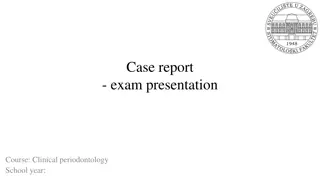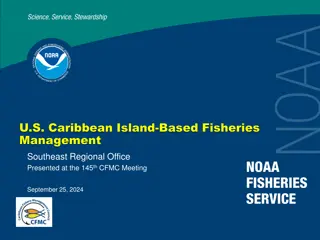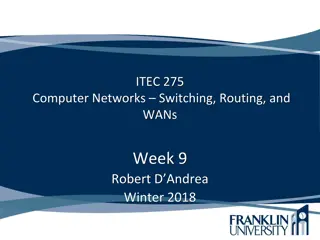Understanding Furcation: Management Strategies in Periodontology
Furcation involvement in periodontal disease presents a challenging area to treat due to its complex anatomy. This article discusses the definition, anatomical considerations, Glickman's classification, therapy objectives, selection of therapeutic modes, therapeutic classes, and treatment techniques such as scaling and root planing with antimicrobial adjuncts.
Download Presentation

Please find below an Image/Link to download the presentation.
The content on the website is provided AS IS for your information and personal use only. It may not be sold, licensed, or shared on other websites without obtaining consent from the author. Download presentation by click this link. If you encounter any issues during the download, it is possible that the publisher has removed the file from their server.
E N D
Presentation Transcript
FURCATION: THE PROBLEM AND ITS MANAGEMENT Dr. Shalini Kaushal Assoc. Prof. Periodontology
Definition It can be defined as: an area of complex anatomic morphology that may be difficult or impossible to be debrided by routine periodontal instrumentation.
Anatomical Considerations Root trunk Furcation entrance Root surface anatomy Enamel projections Accessory canals
Glickman`s Classification(1953) Grade I Incipient Furcation Grade II cul-de-sac Grade III Communicating or Through and Through Furcation Grade IV
Objective of furcation Treatment The elimination of the microbial plaque from the exposed surfaces of the root complex. The establishment of an anatomy of the affected surfaces that facilitates proper self- performed plaque control.
Selection of therapeutic mode Varies with: -The class of furcation defect. -The extent and configuration of bone loss. -Other anatomic factors.
Therapeutic classes of furcation defects Class I: Early defects Class II: a) Shallow horizontal involvement b) Isolated deep class II furcations Class II to IV: Advanced defects
Scaling and root planing In most situations, it results resolution inflammatory lesion in the gingiva. Most effective grade I and shallow grade II. Deeper sites respond less favorably. in the the of in
Antimicrobials Adjunct to scaling and root planning Chlorhexidine Tetracycline fibers No clinically significant difference in clinical parameters after irrigation
Open Debridement Greater calculus removal than closed Ultrasonic Narrow furcations Dome of furcation Surgical access and increased operator experience significantly enhance calculus removal in molar furcation.
Osseous Surgery Most effective in grade II furcation Osteoplasty and ostectomy techniques Remove the lip of defect to reduce horizontal depth Bone ramps into the furcation to enhance plaque control Reduce probing depths
Root Resection Indications Teeth serving as abutments Teeth with furcation defect successfully endodontic procedure Patient considerations Grade II or Grade III treated with
Root Resection Contraindications Inadequate support Fused roots Inoperable endodontically Patient considerations Grade II or grade III bone
Sequence of treatment at RSR Endodontic treatment Provisional restoration RSR Periodontal surgery Final prosthetic restoration
Which root to remove Remove the root- That will eliminate the furcation maintenance. With the greatest amount of bone and attachment loss. That will periodontal problem on adjacent teeth With the greatest number of anatomic problem That least future maintenance. and allow eliminate complicate periodontal
Hemisection Mandibular molars Grade III furcation Need widely separated roots
Tunnel Preparation Grade III furcation Permits plaque removal Root caries (4% stannous fluoride) 25% failure rate at 5 years Recurrent periodontitis
Root Separation Root separation involves the sectioning of the root complex and the maintenance of all roots
Regeneration of Furcation Defects Guided tissue regeneration Predictable outcome of GTR therapy was demonstrated only in grade II furcation involved mandibular molars less favorable results have been reported in other types of furcation defects GTR could be considered in areas with isolated degree II furcation defects
Furcation Defects Most predictable Class II Furcations Mandibular or Buccal Maxillary Furcations Maxillary Class II Mesial or Distal Least predictable Class III Furcations
Osseous Grafting Autogenous bone Allografts Freeze dried bone Demineralized Freeze dried bone Alloplasts Hydroxyapatite Non-porous Porous Bioglass
Extraction Attachment loss is so extensive that no root can be maintained If tooth/gingival anatomy will not allow proper plaque control For endodontic or restorative reason Osseointegrated implant substitute
Prognosis Previous involvement means a hopeless long-term prognosis. concept: Significant furcation Recent trends: Simple periodontal therapy is sufficient to maintain long term prognosis unless development of caries in furcation area.
Prognosis Key to long term success: Thorough diagnosis Selection of patients with good oral hygiene Careful management surgical and restorative
Patients Factors Determine patient`s goals and expectations Screen for local, behavioral and systemic factors; Oral hygiene Compliance Stress Intraoral Accessibility Uncontrolled Diabetes Smoking Healing response to Previous Therapy
MCQs on Furcation management 1.The treatment of choice in grade II furcation involvement is/are a) Nonsurgical periodontal therapy b) Flap procedure c) Odontoplasty and osteoplasty d) Both (b) and (c) 30
MCQs on Furcation management 2. Osseous surgery is most effective in A) Grade I furcation B) Grade II furcation C) Grade III furcation D) None
MCQs on Furcation management 3.Which of the following is a major contraindication to resection of root in furcation management ? a) Inadequate bone support b) Inoperable endodontically c) Poor oral hygiene d) None of the above 32
MCQs on Furcation management 4.Hemisection can be done in A) Mandibular molars B) Grade III furcations C) In widely separated roots D) All
MCQs on Furcation management 5. Recent trend for the prognosis of furcation defect is A) Significant furcation involvement means a hopeless long-term prognosis. B) Simple periodontal therapy is sufficient to maintain long term prognosis. C) Simple periodontal therapy is sufficient to maintain long term development of caries in furcation area. D) None prognosis unless























